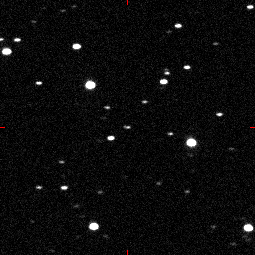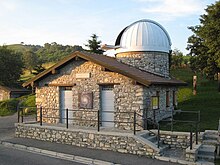(35396) 1997 XF11, provisional designation 1997 XF11, is a kilometer-sized asteroid, classified as a near-Earth object, Mars-crosser and potentially hazardous asteroid of the Apollo group.

Stefano Sposetti is a Swiss amateur astronomer and a prolific discoverer of minor planets. He lives in Gnosca, in the Italian-speaking part of Switzerland in the Ticino Alps, where the Gnosca Observatory is located.
Piero Sicoli is an Italian astronomer and discoverer of minor planets, observing at the Italian Sormano Astronomical Observatory. As the observatory's coordinator, he is responsible for close encounters computation of near-Earth objects (NEOs), orbit computations, and identification of asteroids. The Observatory's focus is the examination and tracking of NEOs in Solar System.
Francesco Manca is an Italian amateur astronomer and discoverer of minor planets at the Sormano Astronomical Observatory in northern Italy.
Marco Cavagna was an Italian amateur astronomer.
Paolo Chiavenna is an Italian amateur astronomer and a co-discoverer of minor planets, credited by the Minor Planet Center with the discovery of 15 minor planets during 1995–2000.
Giovanni de Sanctis is an Italian astronomer and discoverer of minor planets at the Osservatorio Astronomico di Torino in Turin, Italy. His name is sometimes spelt DeSanctis, particularly in the Minor Planet Circulars. The Minor Planet Center credits him with the discovery of 42 numbered minor planets, most of which he discovered at ESO's La Silla site in northern Chile in the early 1980s.
Bassano Bresciano is a comune in the province of Brescia, in Lombardy. As of 2011 Bassano Bresciano had a population of 2,237.
Aldo Di Clemente is an Italian amateur astronomer. He has worked as a technician at the Campo Imperatore station of the Osservatorio astronomico di Roma since 1982. His assistance was valuable in conducting the Campo Imperatore Near-Earth Object Survey (CINEOS).

The Observatory of Turin is an astronomical observatory owned and operated by Italy's National Institute for Astrophysics. It is located on the top of a hill in the town of Pino Torinese near Turin, in the north Italian Piedmont region. The observatory was founded in 1759. At Pino Torinese, several asteroid discoveries were made by Italian astronomer Luigi Volta in the late 1920s and early 1930s. The asteroid 2694 Pino Torinese was named after the observatory's location.

Reedy Creek Observatory is an astronomical observatory the location for observations of near-Earth objects by John Broughton, an Australian amateur astronomer.

The Pistoia Mountains Astronomical Observatory, also known as the San Marcello Observatory and the Pian dei Termini Observatory, is an astronomical observatory in San Marcello Piteglio, Tuscany, central Italy.

The Gnosca Observatory is an astronomical observatory at Gnosca, Ticino, Switzerland. It is owned and operated by amateur astronomer Stefano Sposetti and has the observatory code 143. At Gnosca Observatory, Stefano Sposetti has discovered numerous minor planets (also see Category:Discoveries by Stefano Sposetti).

(137108) 1999 AN10 is a kilometer-length near-Earth asteroid and potentially hazardous asteroid of the Apollo group. It was discovered by LINEAR on 13 January 1999.
9115 Battisti, provisional designation 1997 DG, is a stony Vestian asteroid from the inner regions of the asteroid belt, approximately 5.5 kilometers in diameter. It was discovered on 27 February 1997, by Italian astronomers Piero Sicoli and Francesco Manca at Sormano Astronomical Observatory in northern Italy. The asteroid was named for Italian singer-songwriter Lucio Battisti.
7866 Sicoli, provisional designation 1982 TK, is a stony Nysa asteroid from the inner regions of the asteroid belt, approximately 6 kilometers in diameter. It was discovered on 13 October 1982, by American astronomer Edward Bowell at Lowell's Anderson Mesa Station near Flagstaff, Arizona. The asteroid was named after Italian astronomer Piero Sicoli.

6882 Sormano (prov. designation: 1995 CC1) is an stony Eunomia asteroid from the middle region of the asteroid belt, approximately 7 kilometers (4.3 miles) in diameter. It was discovered on 5 February 1995, by Italian amateur astronomers Piero Sicoli and Valter Giuliani at Sormano Astronomical Observatory in northern Italy. The asteroid was named for the Italian mountain-village of Sormano and its discovering observatory.
6090 Aulis, provisional designation: 1989 DJ, is a Jupiter trojan from the Greek camp, approximately 70 kilometers in diameter. It was discovered on 27 February 1989, by Belgian astronomer Henri Debehogne at ESO's La Silla Observatory in northern Chile. The dark Jovian asteroid belongs to the 50 largest Jupiter trojans and has a rotation period of 18.5 hours. It was named for the ancient Greek port Aulis, mentioned in the Iliad.
Felix Hormuth (born 1975) is a German astronomer, working at the Max Planck Institute for Astronomy (MPIA) until 2016, and a prolific discoverer of minor planets. During his stay at the Calar Alto Observatory in Spain, he has discovered many asteroids, including a Jupiter trojan and two near-Earth objects, such as the 15-meter Amor asteroid 2009 DS36, using MPIA's 1.23-meter reflector telescope.
2013 GM3 is a micro-asteroid, classified as near-Earth object of the Aten group, approximately 20 meters in diameter. It was first observed on 3 April 2013, by astronomers of the Mount Lemmon Survey conducted at the Mount Lemmon Observatory near Tucson, Arizona, United States.








